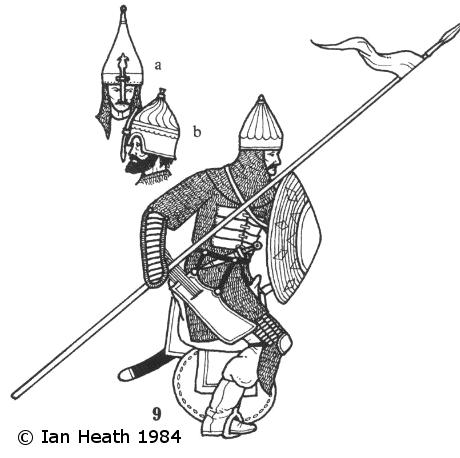 9. OTTOMAN HEAVY CAVALRYMAN
9. OTTOMAN HEAVY CAVALRYMANThis figure, based on surviving 14th-15th century armours in the Topkapi and Turkiye Askeri museums in Istanbul, wears a variation on the armour worn by 8, of a type which was widespread amongst Turks, Mamluks and Persians alike (see also 17 and 32). His helmet is the predominant Turkish type, called a chichak, which was usually tall and pointed, and often fluted as well. In addition it often had a nasal by the first half of the 15th century, or possibly even earlier; Doukas’ reference to the death of Umur Pasha of Aydin at the assault on Smyrna in 1347 being the result of his ‘visor’ being ‘pierced . . . between the eyebrows’ may be an allusion to a nasal-bar on the amir’s helmet, 9a and b depict two alternative types of helmet, 9a being another chichak dating to c. 1400-50 while b is a ‘turban’ helmet, so-called as a result of being designed in such a way that it could be worn over a turban; this one, like most, has a plume-tube atop the conical crown (though plumes were apparently little worn in battle at this date).
His armament comprises typical sipahi combination of bow, kilij, dagger and lance, to which an axe or mace was often added (but see also note to figures 1 and 2). His shield is of the cane variety described under figure 27, though Janus Lascaris describes sipahi shields as ‘wooden targets like those of the stradiots’. The source from which figure 62 comes shows 4 Ottoman shields exactly like that of the Trapezuntine depicted, plus a fifth that appears to be a pavise like that carried by 126; both types may very well have been carried by 15th century stradiots.
By the 15th century most sipahis were armoured, as is indicated by the assorted terms used to describe them, such as cebeli (from cebe, a corselet), burume (a mail corselet), and gecim (armour for man and horse). It is apparent from sources of Mehmed II’s reign that most of the cebelu in fact wore only a sleeveless, quilted cotton armour called a bagirdaq, often worn in addition under their mail by timariots, but by the end of the century Lascaris was of the opinion that the majority of sipahis had at least a mail corselet and a helmet.
